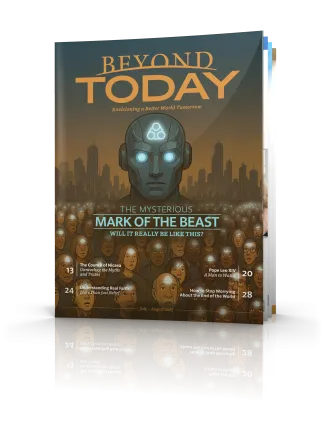Understanding Real Faith: More Than Just Belief

There’s more to biblical faith than believing. We must learn to live by it and rely on it—and continue to grow in it.
Many assume that faith is simply believing strongly enough in something. When Jesus’ disciples asked Him to increase their faith, He responded with what seems like an extraordinary example—that faith as small as a mustard seed could command a mulberry tree to uproot itself and plant itself in the sea (Luke 17:5-6). But was Jesus suggesting walking around performing overt miracles by concentrating really hard to prod God to act as we desire? Or was He teaching us something deeper about what real faith entails?
To grasp what genuine faith looks like in practice, we need to understand that faith is more complex than just believing. The book of James tells us that even demons believe in God—and tremble—yet we wouldn’t say they have faith (James 2:19). Real, living faith requires three essential elements working together—belief, action and trust.
Belief is the beginning
First, let’s consider belief. The Merriam-Webster dictionary defines belief as a state of mind where trust or confidence is placed in someone or something. For Christians, this means accepting that God exists and that He rewards those who earnestly seek Him (Hebrews 11:6). But our beliefs aren’t static. They’re choices we make and can change over time as we grow in understanding.
Modern science has even begun to understand how our brains process and modify beliefs. When we encounter new information or experiences that challenge our existing beliefs, we experience what psychologists call cognitive dissonance—mental tension that occurs when two beliefs conflict. We see this played out dramatically in Peter’s experience of walking on water (Matthew 14:22-31). Peter believed Jesus could enable him to walk on water, yet he also knew from lifetime experience that people can’t do that. When faced with raging wind and waves, the cognitive dissonance forced him to choose what to accept.
The example of Thomas also shows us how belief requires choosing between our physical understanding and God’s reality. When told about Jesus’s resurrection, Thomas declared, “Unless I see in His hands the print of the nails . . . I will not believe” (John 20:25). Like Peter’s thinking that human beings can’t walk on water, Thomas reasoned that dead men don’t rise. When confronted with the risen Christ, he had to choose between what his experience told him was possible and what God was revealing. His response—“My Lord and my God!” (verse 28)—shows his resolution of this conflict by accepting God’s reality over his human understanding.
Demonstrated through actions
This brings us to the second element of faith—action. James explains this crucial component: “What does it profit, my brethren, if someone says he has faith but does not have works? Can faith save him?” (James 2:14). He goes on to use the practical example of seeing a brother or sister without food or clothing. Simply wishing them well without taking action to help profits nothing, as does a faith that is mere belief without righteous deeds—it’s a dead faith ((James 2:15-17).
Consider Abraham, often called the father of the faithful. When God commanded him to leave his homeland for an unknown destination, “by faith Abraham obeyed when he was called to go out to the place which he would receive as an inheritance. And he went out, not knowing where he was going” (Hebrews 11:8). Abraham’s faith wasn’t just mental agreement with God’s promises—it was demonstrated through decisive action in the face of uncertainty.
Daniel also demonstrated his faith by action. When faced with a royal decree to eat food that violated God’s laws, he didn’t just believe God’s ways were right—he acted on that belief. Daniel “purposed in his heart that he would not defile himself” (Daniel 1:8) and proposed a test of eating only vegetables and water, even though this stand could have cost him his position or life. His faith wasn’t just mental agreement with God’s laws—it required concrete action that put him at risk.
Developing abiding trust
The third essential element of faith is trust—and this is where many stumble, even after believing and taking action. We see this illustrated dramatically in the life of Elijah. Here was a prophet who had called down fire from heaven, outran a chariot, and saw God provide miraculously through ravens and an endless supply of flour and oil (1 Kings 17-18). Yet when threatened by Queen Jezebel, his trust faltered and he fled in fear, even asking God to take his life (1 Kings 19:1-4). His belief in God’s existence hadn’t changed, but his trust in God’s protection wavered under pressure.
We see the trust dynamic in King Hezekiah’s story with a different outcome. When Jerusalem was surrounded by the mighty Assyrian army, he responded by laying the enemy’s threatening letter before God in prayer, saying, “O Lord our God, save us” (Isaiah 37:20). Unlike Elijah’s moment of fear, Hezekiah demonstrated trust in God even when facing imminent destruction, choosing to rely on God’s protection rather than give in to fear.
Trust means relying on God’s character and promises even when circumstances seem to contradict them. When Abraham was asked to sacrifice Isaac, he faced an apparent contradiction between God’s promise (that Isaac would continue his lineage) and God’s command. His trust in God’s character led him to conclude that God could raise Isaac from the dead if necessary to keep His word (Hebrews 11:19).
The examples recorded in Hebrews 11, often called the faith chapter, show us that real faith isn’t about performing spectacular miracles on a whim. Rather, it’s about ordinary people who choose to believe God and act on that belief even if doing so seems illogical by human standards. Noah built an ark before any rain had fallen. Moses chose to suffer with God’s people rather than enjoy the privileged life of Pharaoh’s household. Gideon made massive troop cuts to face an army that was already many times the size of his own. All these weren’t necessarily dramatic moments; they were choices to trust God’s way over human reasoning.
Practicing our faith—and growing in it
This understanding of faith has practical implications for us today. If we were put on trial for being Christians, would there be enough evidence in our daily actions to convict us? Real faith isn’t measured by our ability to perform miracles or make trees uproot and replant themselves in the sea. Instead, it’s demonstrated in how we live each day—in our choices to obey God’s commands even when it’s difficult, in our decisions to trust His promises even when circumstances look bleak, and in our actions that show we believe His way is best.
When we face decisions at work about honesty in our business dealings, when we choose how to treat someone who has wronged us, when we decide how to use our resources—these are the moments that reveal whether we have living faith. Do we merely believe in God’s existence, or do we trust His way enough to act on it?
The good news is that faith can grow. Like Abraham, we may stumble in our trust at times, but God is patient with our growth. The father who brought his demon-possessed son to Jesus expressed this journey honestly when he cried out, “Lord, I believe; help my unbelief!” (Mark 9:24). This man recognized both his faith and his need for it to grow stronger.
As we face our own trials and challenges, we should remember that real faith isn’t about never having doubts. It’s about choosing to trust God despite those doubts. It’s not about never failing. It’s about getting back up and continuing to follow God’s way even after we’ve failed. And it’s not about performing spectacular signs. It’s about living each day in a way that demonstrates we believe God’s promises and trust His guidance.
The ultimate example of faith is Jesus Christ Himself, “the author and finisher of our faith” (Hebrews 12:2). Even when facing death, He demonstrated perfect trust in His Father’s will and purpose. As we follow His example and keep our eyes fixed on Him, our own faith can grow stronger—not just in belief, but in the actions and trust that make faith complete.
Real faith, then, is not merely intellectual assent to God’s existence or even just belief in His power. It’s a living, active trust that shapes how we live each day. When we understand this, we realize that increasing our faith isn’t about gaining power to perform obvious miracles. It’s about growing in our trust in God and our willingness to follow His way in every aspect of our lives. This deep transformation is the greater miracle from God!







